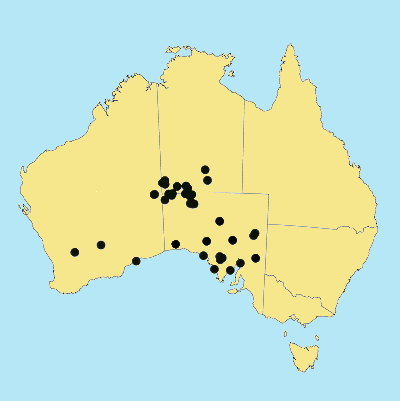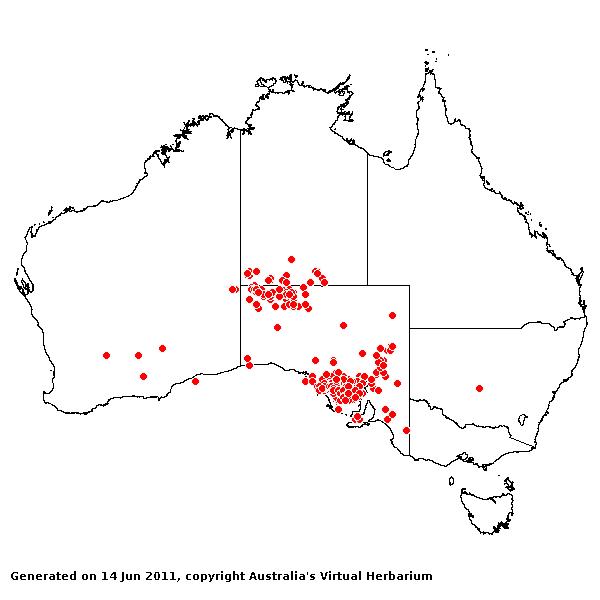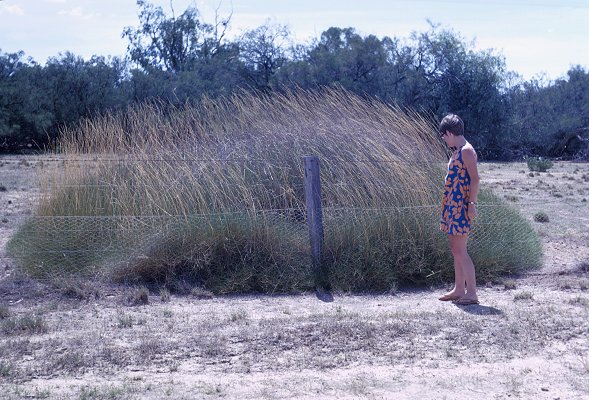Triodia irritans R.
Br. Prodr. 182 (1810).
Classification. (GPWG 2001) : Subfamily Chloridoideae. Triodeae.
Type of Basionym or
Protologue Information: HT: Robert Brown 6258, 7 Feb 1802, Austrlia:
South Coast Id. 4, St Peter's Isle, off Denial Bay (BM).
Key references
(books and floras): [1810]. R.Brown, Prodromus (182), [1878]
G.Bentham, Flora Australiensis 7 (607), [1952] C.A.Gardner, Flora of
Western Australia 1 Gramineae (76), [1981] M.Lazarides in J.Jessop
(ed)., Flora of Central Australia (445), [2002] D.Sharp & B.K.Simon,
AusGrass, Grasses of Australia, [2006] J.Jessop, G.R.M.Dashorst,
F.M.James, Grasses of South Australia (413).
Illustrations:
[1952] C.A.Gardner, Flora of Western Australia 1 Gramineae (71,
Pl. 21), [2006] J.Jessop, G.R.M.Dashorst, F.M.James, Grasses of South
Australia (413, fig. 343 & plate
15), [1984] N.T.Burbidge. rev. S.W.L.Jacobs,
Australian Grasses (261 as T.
irritans var. laxispicata).
Habit. Perennial. Culms 30–100 cm tall. Ligule a fringe of hairs.
Leaf-blades straight, aciculate, conduplicate, 5–25 cm long, 0.5–2 mm wide.
Inflorescence.
Inflorescence compound, a panicle. Panicle linear or elliptic or oblong,
5–12(–19) cm long, 1.5–4 cm wide.
Spikelets.
Spikelets pedicelled. Fertile spikelets many flowered, with at least 2 fertile
florets (5–10), comprising 5–10 fertile floret(s), with diminished florets at
the apex, cuneate, laterally compressed or terete, 11–30 mm long.
Glumes.
Glumes similar, thinner than fertile lemma. Lower glume lanceolate, scarious or
cartilaginous, keeled (slightly), 1-keeled, 3–5(–7) -nerved. Lower glume
surface glabrous. Lower glume apex muticous or mucronate. Upper glume
lanceolate, 9–26 mm long, scarious or cartilaginous, keeled (slightly),
1-keeled, 3–5(–7) -nerved. Upper glume surface glabrous. Upper glume apex
entire or lobed, muticous or mucronate.
Florets.
Fertile lemma 6–12 mm long, without keel or keeled, 3(–9) -nerved. Lemma
surface indumented. Lemma apex dentate or lobed, mucronate, 1 -awned. Median
(principal) awn from a sinus, 0.5–6 mm long overall. Lodicules present. Anthers
3.
Continental
Distribution: Australasia.
Australian Distribution:
Western Australia, Northern Territory, South Australia.
Western Australia:
Roe, Coolgardie. Northern Territory: Central Australia South. South
Australia: North-western, Lake Eyre, Nullabor, Gairdner-Torrens Basin,
Flinders Ranges, Eastern, Eyre Peninsula, Southern Lofty.
Notes.
Distinguished by the usually dense relatively wide often partly exserted
panicle; often cuneate and closely flowered spikelets; scarious or
cartilaginous, lanceolate acuminate, often mucronate relatively long glumes
which usually determine the length and shape of the spikelet; scarious or
cartilaginous, often sparsely hairy, 2-lobed, mucronate or shortly awned
lemmas; scarious or cartilagnous, relatively short usually glabrous palea with
wingless keels thickened and smooth in the lower part, and acute and scabrous
upwards, and partly scabrous-hairy flaps; often compact rounded tussocks.
Often confused with T. scariosa, but
distinguished by the usually broader, denser, shorter partly exserted panicle,
differently shaped and closer flowered spikelets, longer narrower glumes, less
hairy usually 2-lobed annd awned lemmas, and relatively short often glabrous
paleas.
S of
26°S in W.A., S of 24°S in N.T. and S.A. Chiefly in skeletal or shallow, stony
or rocky soils on quartzite and granite hills and ranges, often in creeks, rock
crevices, gullies and valleys; also limestone soils, saline flats, coastal
dunes above a high cliff, sandplains, flats in red sandy loam; flowers all
seasons.





